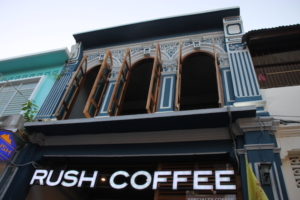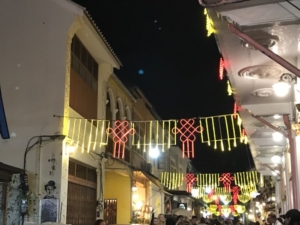I got my first look at Thailand’s Phuket (the town) in late 2019 and regret that I did not have additional time there to absorb more about the local history, customs and architecture. The visit was a tease, which is why this blog will be a tease as well.

There are temples to see in Phuket, like this one glimpsed quickly on my visit.
Phuket is both an island and a town. The island, in the Andaman Sea off the coast of southwest Thailand, is best known for its beaches. Mountainous and covered with rain forests, the island is connected to the mainland by bridge.
The eponymous town is the largest urban area on the island. It counts more than 75,000 residents, but that statistic is fairly old; I cannot find a recent figure.
I was with other journalists in Thailand to spend quite a bit of time at resorts (Baba Beach Club Phuket and Sri panwa), but our group made one trip to town, specifically Phuket Old Town, the part of town with the greatest visual interest and a productive shopping site, too.

Renovated Sino-Portuguese shophouse, with distinct decorative features, seen on Rommani Street.
In fact, our visit, with arrival at 5:45 p.m. on a Sunday, was timed to coincide with a large weekly night market, featuring both food and consumer goods, that fills the Old Town’s walking street, Thalang Road.

Above and below, restored Sino-Portuguese houses that overlook Phuket’s night market on Thalang Road, a walking street.


Wall art seen on Thalang Road, site of a night market in Phuket Old Town. Of interest to bird lovers, Phuket Bird Park is near Wat Chalong on Phuket island.
I focused first on the architecture, camera in hand, hastening to capture as much as I could before the sun set. Many of the buildings are two stories tall and some have very decorative features at the second level. Some need work, but others have already seen serious investment.
The buildings generally date from the 19th century, built in what is called the Sino-Portuguese style, a marriage of Chinese and European traditions. Chinese workers built the homes for Portuguese traders in a time when locally mined tin brought significant wealth to the island.
Many houses, called shophouses (shops at ground level, residences upstairs), have been repurposed as restaurants, stores and the like.

Restored Sino-Portuguese buildings on Rommani, a side street just off Phuket’s walking street, Thalang Road.

Orta Cafe, located in a shophouse also found on Rommani in Phuket Old Town.

An example of a Sino-Portuguese house awaiting its restoration.
Members of my press group were hosted to a session in a popular sweet shop, Torry’s Ice Cream Boutique, for ice creams, cookies of various sorts and sticky rice. Our hosts ordered several choices, and we all tasted each.
The shop itself is quite tastefully done up with dark wood display cases and other elements, all situated in two former shophouses that have been combined.

Interior of Torry’s Ice Cream Boutique, a pair of converted shophouses, in Phuket Old Town.

My group’s selection of shared sweets served at Torry’s Ice Cream Boutique in Phuket Old Town.
We allotted enough time to return to the market, now dark, for some quick shopping. Having previously spotted stores where I could get gifts for family, I made quick work of this, spending nearly every baht I owned, for cost-effective but distinctive items.

Phuket Old Town side street lighted for after-dark visitors.
Back scratchers were a surprise choice but, I was told later, they are a typical thing in a Thai home. Indeed, there were back scratchers in all rooms at the resorts where we stayed.
We regrouped to walk a few blocks to another repurposed house (not a shophouse this time), dating back about a century. It still retains a central staircase and the walls that would have demarcated the rooms in a reasonably sizeable home.

Raya Restaurant, a two-story home converted into an eatery, adding to the diverse range of dining choices that gained Phuket the UNESCO designation as a City of Gastronomy.
This was the Raya Restaurant. Dinner comprised numerous Thai choices served family style, including a local comfort food resembling an omelet; it proved tasty and not overly spicy. The Raya does not sell wine by the glass so a few of us shared a bottle of red.
As noted, my visit was a glimpse, but there are some points to add here. During this Phuket visit, my press group (my companions were food writers) spent more time looking at and consuming food than we spent looking at the town. This seemed appropriate given that UNESCO, as part of its Creative City program, dubbed Phuket a City of Gastronomy a few years ago.
Furthermore, Thai officials are now working toward having Phuket Old Town added to the list of UNESCO World Heritage sites. So, yes, this is a spot worth more time than I was able to give it.
Next time.
For more information about Thailand, we offer at BestTripChoices.com the following, under the headline, Siam today, at https://besttripchoices.com/thailand/
This blog and its photos are by Nadine Godwin, BestTripChoices.com editorial director and contributor to the trade newspaper, Travel Weekly. She also is the author of “Travia: The Ultimate Book of Travel Trivia.”
